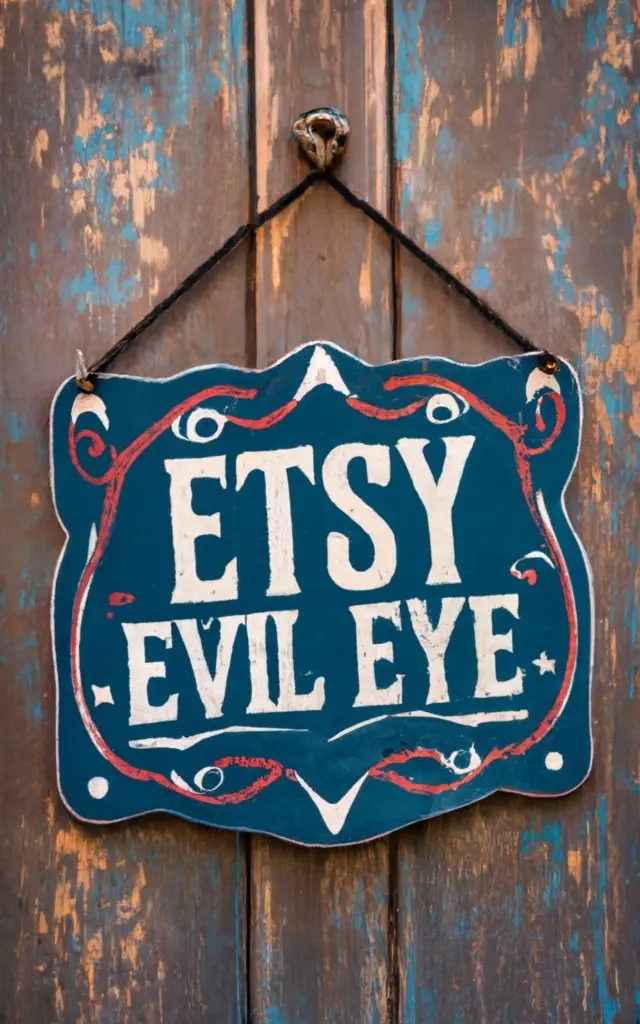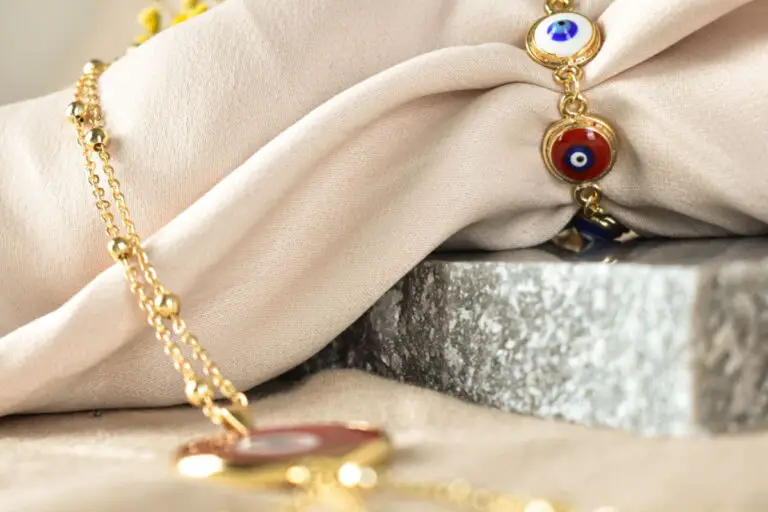Where Does Evil Eye Come From? Explained!

Quick Article Takeaway
The belief in the evil eye, present in many cultures throughout history, is the notion that a malevolent gaze can bring harm.
Protection methods like amulets, gestures, and rituals have developed over time. Symptom recognition is crucial, as physical and emotional changes are linked to the evil eye.
This belief has adapted to different cultures and religions, often tied to symptom recognition.
To ward off the evil eye, people use amulets, rituals, and symbolic objects as safeguards against harm.
Introduction
Where Does Evil Eye Come From? The belief in the evil eye, with its origins in ancient cultures, is a captivating concept that transcends time and place. This enigmatic phenomenon suggests that some individuals possess the power to bring harm or misfortune by merely looking at others. While some may dismiss it as superstition, the evil eye’s enduring presence in various cultures and its influence on mythology, history, religion, literature, and protective practices highlight its profound impact on human imagination and understanding of unseen forces shaping our lives.
To delve deeper into the mysteries of the evil eye and explore related topics, visit our website at HobbyistGeek.com. Discover a wealth of information and join our community of enthusiasts who share your curiosity.
What is the evil eye and where did it come from?
The concept of the evil eye has fascinated and intrigued people across cultures and throughout history. It is a belief rooted in ancient traditions and has been passed down through generations, capturing the imaginations of countless individuals.
The evil eye is commonly understood as a malevolent gaze or glance that possesses the power to bring misfortune or harm to its recipient. This intriguing belief can be traced back to various religious beliefs, literary examples, and mythological references.
In terms of religious beliefs, the evil eye can be found in different faiths around the world. For instance, in Judaism, the concept of the evil eye is mentioned in ancient texts such as the Talmud and Kabbalah.
It is believed that envy and jealousy can manifest through one’s eyes, leading to potential harm being inflicted upon others. Similarly, in Islam, there are references to protecting oneself from the evil eye through prayers and supplications.
When exploring literary examples, we find that numerous works of literature have made reference to the evil eye. One notable example is Shakespeare’s play “Othello,” where Iago’s character symbolizes envy and malevolence by casting an evil eye on Othello’s relationship with Desdemona.
This demonstrates how deeply ingrained this belief was even during Shakespearean times. The evolution of this belief showcases its historical significance within various cultures worldwide.
Over time, interpretations have varied greatly depending on regional variations and cultural beliefs. In some cultures like those found in Mediterranean countries such as Greece or Turkey, it is believed that blue beads or amulets can ward off the effects of an evil eye gaze.
Despite its prevalence throughout history, there are common misconceptions surrounding the evil eye. Some people may assume that it is purely a superstitious belief without any basis in reality.
However, for many communities who hold this belief dear, it serves as a way to explain misfortune or protect oneself from negative energy. To counteract the potential harm caused by an evil eye, numerous protection methods have been developed.
For instance, in certain cultures, people may wear a talisman or amulet known as a “nazar” to ward off the negative effects. Others may recite prayers or perform rituals to protect themselves from such malevolent glances.
Recognizing symptoms associated with the evil eye is also significant in this belief system. Some common symptoms include sudden illness, unexplained financial loss, or relationships deteriorating without apparent cause.
These signs are often considered indicative of being affected by an evil eye. The evil eye is a belief deeply ingrained in various cultures and has its roots in ancient folklore origins.
It has evolved and spread through religious beliefs, literary examples, and cultural practices across different regions of the world. Despite misconceptions surrounding it, the concept holds great significance for many individuals who seek protection from its potentially harmful effects.
How long has the belief in the evil eye been around?
The belief in the evil eye has a long and fascinating history, tracing its roots back thousands of years. It is difficult to pinpoint an exact timeline for when this belief originated, as it predates recorded history. However, evidence suggests that the concept of the evil eye can be found in various cultures across different regions of the world.
In ancient civilizations such as Mesopotamia, Egypt, and Greece, the belief in the evil eye was deeply ingrained in their cultural beliefs. Mythological references to the evil eye can be found in these ancient civilizations’ religious texts and folklore origins.
For example, in Greek mythology, it is said that Athena possessed a powerful gaze that could cause harm to those she looked upon with anger or envy. The historical significance of the belief in the evil eye is also evident in literary examples from classical literature.
The works of authors like Homer and Pliny depict characters being afflicted by the malevolent effects of the evil eye. These literary examples serve as a testament to how deeply ingrained this belief was in society during those times.
Over time, as civilizations evolved and spread across different regions of the world, variations and adaptations occurred within the belief system surrounding the evil eye. Regional variations became apparent in how people perceived and protected themselves from its effects.
For instance, some cultures believed that certain objects or gestures could ward off the evil eye, while others relied on amulets or talismans for protection. Religious beliefs also played a significant role in shaping beliefs surrounding the evil eye.
In many cultures where Christianity is prevalent today, such as Italy or Spain, there are still remnants of superstitious practices related to warding off the evil eye. On top of religious influences on cultural beliefs surrounding this phenomenon are common misconceptions about its true nature.
Overall, understanding how long belief in the evil eye has been around requires delving into its mythological references found throughout ancient civilizations’ texts and recognizing its significant historical and cultural significance. The belief in the evil eye has evolved over time, adapting to different regional variations and religious beliefs.
Today, the evil eye continues to be a prevalent concept in many parts of the world, with various protection methods still employed by those who fear its malevolent effects. Its longevity as a belief system highlights its enduring impact on human societies throughout history.
What is the history of the evil eye?
The history of the evil eye is a fascinating journey into the depths of human beliefs and superstitions. This concept can be traced back to ancient civilizations, with references found in various cultures across the globe. The evil eye has been mentioned in different forms of literature, making it a timeless and captivating subject.
In terms of historical significance, the belief in the evil eye dates back thousands of years. In ancient Greece and Rome, it was considered a potent and malevolent force capable of causing harm or misfortune to those who were targeted by its gaze.
Mythological references often depict gods and goddesses using their eyes as weapons, further cementing the idea that the power lies within sight itself. Folklore origins play a significant role in shaping our understanding of this phenomenon.
Many cultures believe that certain individuals possess an innate ability to cast an evil eye upon others, either intentionally or unintentionally. This belief often stems from observations of misfortune befalling those who are consistently subjected to envy or jealousy.
Religious beliefs also intertwine with the history of the evil eye. In some faiths, it is seen as a form of spiritual attack caused by negative energies or demonic entities.
Consequently, protection methods have evolved within these religious contexts to ward off its effects through rituals or talismans. Moreover, regional variations exist in how this belief is interpreted and understood.
For instance, Mediterranean cultures have deeply rooted beliefs in the evil eye known as “Mal de Ojo” in Spanish or “Nazar” in Turkish. The symptoms associated with being affected by the evil eye can vary across regions but commonly include physical ailments such as headaches, fatigue, or general feelings of unease.
Despite its long-standing presence throughout history and numerous cultural interpretations, there are still common misconceptions surrounding the evil eye. Some may dismiss it as mere superstition while others may mistakenly believe that it exclusively affects those who are wealthy or successful.
The history of the evil eye is a rich tapestry woven with literary examples, religious beliefs, folklore origins, mythological references, symptom recognition, regional variations, historical significance, and common misconceptions. It reflects the deep-rooted cultural beliefs of various civilizations and offers valuable insights into our collective understanding of the mysteries of the human experience.
What are some famous examples of the evil eye in literature or mythology?
Throughout history, the concept of the evil eye has made its mark in literature and mythology, transcending cultures and time periods. One of the most famous examples can be found in ancient Greek mythology, with the story of Medusa.
According to legend, Medusa possessed such a powerful gaze that anyone who looked into her eyes would turn to stone. This tale not only showcases the belief in the destructive power of an envious or malevolent gaze but also highlights how deeply rooted this idea is in our collective consciousness.
Moving away from mythology and into literature, we find numerous references to the evil eye. In William Shakespeare’s play “Othello,” for instance, there is a notable mention of this malevolent force.
The character Iago manipulates Othello’s perception by suggesting that his wife Desdemona has been unfaithful, using phrases like “the green-eyed monster” to describe jealousy’s ability to consume one’s mind and lead them astray. Furthermore, many cultures have their own folklore origins surrounding the evil eye.
In Middle Eastern countries such as Turkey and Greece, there are tales of individuals capable of casting a curse with just a single glance. These stories often depict individuals with extraordinary powers or magical abilities that can cause harm simply by looking at someone with ill intent.
In Indian mythology, there is a similar concept known as “Drishti,” believed to be an evil gaze that can bring misfortune upon those who receive it. It is considered so potent that various rituals and protective measures are employed to ward off its effects.
These mythological references and literary examples demonstrate the historical significance of the evil eye across various cultures and belief systems. They highlight how this notion has been ingrained in our collective imagination for centuries, influencing our perceptions and shaping cultural beliefs surrounding envy and its potential consequences.
What cultures believe in the evil eye?
Cultural Beliefs: The belief in the evil eye spans across various cultures around the world. From the Mediterranean region to parts of Africa, Asia, and even Latin America, different societies have incorporated this concept into their folklore and cultural beliefs.
In Greece, for instance, the evil eye is known as “matiasma” or “vaskania,” and it is deeply ingrained in Greek culture. Similarly, in Turkey, it is referred to as “nazar” and is believed to bring bad luck or harm to those who receive its gaze.
Literary Examples: The evil eye has also found its way into literature and storytelling throughout history.
In Edgar Allan Poe’s famous gothic tale “The Tell-Tale Heart,” the protagonist feels a malevolent eye constantly observing him, which eventually drives him to commit a heinous crime. This serves as a chilling depiction of how the evil eye can consume one’s psyche with paranoia and obsession.
Religious Beliefs: Religions such as Islam incorporate beliefs in the evil eye within their teachings.
It is mentioned in Islamic texts that Prophet Muhammad warned his followers about its existence and advised them on protective measures against it. Similarly, the concept of an envious gaze causing harm can be found within Judaism, where it is known as “ayin hara.”
Regional Variations: While there are similarities in beliefs surrounding the evil eye across cultures, there are also regional variations.
For example, in India, it is widely referred to as “drishti” or “nazar” and believed to cause physical ailments or misfortune. In some parts of Mexico and Central America, people use amulets like red chili peppers or a hand-shaped symbol called “mano de azabache” to ward off the negative effects of an envious glance.
Protection Methods: Given its historical significance and widespread belief in its power, various protection methods against the evil eye have emerged over time.
These include wearing talismans or amulets, such as the Turkish Nazar boncuk (a blue eye-shaped charm), or using specific gestures and symbols to ward off its effects. Additionally, rituals involving prayers, blessings, or the burning of certain herbs are also employed as protective measures.
In exploring the cultural beliefs surrounding the evil eye, we gain insight into its pervasive nature and the diverse ways in which it has influenced different societies throughout history. Understanding these beliefs helps us appreciate the significance of this age-old concept in shaping cultural practices and providing comfort in times of uncertainty and fear.
How has the belief in the evil eye evolved over time?
Belief in the evil eye has a long and fascinating history that has evolved over time. In ancient times, the belief in the evil eye was deeply rooted in superstition and fear. People believed that certain individuals possessed a powerful gaze that could bring harm or misfortune upon others.
These individuals were often feared and avoided, as their mere presence was thought to be a potential threat. As societies progressed and became more civilized, the belief in the evil eye began to take on different forms and interpretations.
In some cultures, it became associated with envy or jealousy rather than an actual physical gaze. It was believed that someone who harbored envy towards another person could inadvertently cast the evil eye upon them.
Over time, people developed various methods of protection against the evil eye. Amulets and talismans were commonly used as a means of warding off its negative effects.
These objects were believed to possess special powers that could counteract the malevolent energy associated with the evil eye. Other methods included reciting prayers or performing rituals to invoke divine protection.
Religious beliefs also played a significant role in shaping how the evil eye was perceived and understood. Different religions had their own interpretations of this phenomenon, incorporating it into their respective mythologies and folklore origins.
For example, in Greek mythology, it is said that Medusa possessed an evil eye that could turn anyone who looked at her into stone. In literature as well, there are numerous examples of the evil eye being referenced or portrayed as a symbol of malevolence or danger.
From ancient texts like “The Odyssey” by Homer to more contemporary works like Edgar Allan Poe’s “The Tell-Tale Heart,” writers have explored this concept through different characters and narratives. It is important to note that there are common misconceptions surrounding the nature of the evil eye.
Some people mistakenly believe that it is solely rooted in superstition or folklore without any real basis in reality. However, for those who genuinely believe in its power, the evil eye is a very real and potent force.
The belief in the evil eye has also varied across different regions and cultures. While it is widely known and recognized in Mediterranean countries, such as Greece, Turkey, and Italy, it may be less prevalent or even absent in other parts of the world.
In some regions, certain rituals or practices associated with the evil eye may have been adapted or integrated into local customs and traditions. The belief in the evil eye has undergone a fascinating evolution throughout history.
From its roots in ancient superstition to its incorporation into religious beliefs and cultural practices, it continues to intrigue and captivate people’s imaginations. Whether one sees it as a mere mythological reference or a genuine phenomenon with historical significance, the belief in the evil eye remains deeply ingrained within various societies around the world.
What are some common misconceptions about the evil eye?
One common misconception about the evil eye is that it is always intentionally cast by someone who wishes harm upon another. While it is true that some individuals may intentionally direct negative energy towards others, the evil eye can also be unintentional.
In many cases, a person may inadvertently project envy or jealousy towards someone else, unknowingly causing harm through the power of their thoughts and emotions. This highlights the importance of recognizing that not all instances of the evil eye are malicious in nature.
Another misconception is that the evil eye only affects individuals who are weak or vulnerable. This belief fails to acknowledge that anyone can be susceptible to its influence, regardless of their strength or resilience.
The evil eye does not discriminate based on personal characteristics but rather operates on a more metaphysical level, affecting individuals from all walks of life. Furthermore, there is a misconception that the evil eye can only be transmitted through direct gaze.
While it is true that the concept of eye contact plays a significant role in some cultural beliefs surrounding the evil eye, it is not limited to this form of transmission. The mere thought or projection of envy or ill will towards another person can potentially manifest as an evil eye’s effects.
It is also important to dispel the myth that protection against the evil eye requires elaborate rituals or expensive objects. While certain cultures have developed specific practices and talismans to ward off its effects, protection methods vary widely across different regions and religions.
Simple acts such as wearing certain colors, using hand gestures like making a fist with your thumb tucked inside your palm (known as “figa”), or hanging up protective symbols like Nazar amulets can offer defense against its influence. One must address the misconception that belief in the evil eye has no basis in reality and exists solely within folklore and superstition.
Throughout history, numerous references to this phenomenon can be found across cultural beliefs, religious texts, mythological references, and even literary examples. Its historical significance and widespread recognition suggest that the evil eye holds a place in our collective consciousness, transcending mere superstition.
By addressing these common misconceptions, we can gain a deeper understanding of the evil eye and its influence on various aspects of human existence. It is crucial to approach this subject with an open mind, acknowledging the diverse cultural beliefs and interpretations surrounding its existence while discerning fact from fiction.
What are the different ways to protect oneself from the evil eye?
One of the most intriguing aspects of the evil eye phenomenon is the myriad of protective methods that have been developed over time. People from different cultures and regions have devised various strategies to shield themselves from its malevolent gaze.
Protection methods range from wearing specific amulets or talismans to performing rituals and using certain objects believed to repel the evil eye. In many cultures, one common practice is wearing an evil eye amulet or charm, often in the form of a pendant or bracelet.
These amulets are typically made with blue glass or stone, as blue is believed to possess powerful protective qualities against the evil eye. The blue color is thought to reflect back any negativity directed towards the wearer, effectively warding off harm.
Another protection method involves performing rituals or prayers to counteract the effects of the evil eye. This can be observed in various religious traditions where individuals seek divine intervention through prayer and supplication.
For instance, in some Middle Eastern cultures, people recite specific verses from holy texts or perform cleansing rituals involving water and salt. Certain objects are also believed to have innate protective powers against the evil eye.
For instance, in Greece and Turkey, a popular symbol called a nazar is widely used for protection. Nazars are typically designed as blue-eyed glass beads or ornaments believed to absorb negative energies and protect against the malevolence of the evil eye.
While these protection methods may differ across cultures and regions, they all share a common goal: safeguarding individuals from potential harm caused by this age-old belief in supernatural negativity. Whether it’s through wearing amulets, performing rituals, or relying on symbolic objects as shields against malevolent forces, these practices serve as tangible expressions of people’s desire for protection and well-being.
Overall, understanding how different societies approach protection against the evil eye provides valuable insights into their cultural beliefs and historical significance surrounding this ancient phenomenon. It showcases how regional variations influence people’s perceptions and responses to the evil eye, reflecting the intricate tapestry of human belief systems and folklore origins.
What are the symptoms of the evil eye?
Symptom Recognition: Recognizing the symptoms of the evil eye is essential for understanding whether someone has been affected by its malevolent gaze. Although the manifestations may vary across cultures, there are some common symptoms that are often associated with the evil eye.
One of the most prevalent indications is sudden and unexplained physical discomfort or pain. This can range from headaches and dizziness to stomachaches and fatigue.
People affected by the evil eye might also experience a sense of unease or restlessness, as if something sinister is lurking around them. Some may even notice changes in their behavior or mood, becoming irritable, anxious, or unusually withdrawn.
Furthermore, it’s important to note that symptom recognition is not limited to physical and emotional discomfort alone. In certain cases, individuals who have fallen victim to the evil eye may witness a string of misfortunes or accidents seemingly befalling them one after another.
These unfortunate events could include financial losses, relationship problems, or even accidents and illnesses affecting their loved ones. Such occurrences are often attributed to the malevolent energy unleashed by someone casting an envious look.
It’s crucial to remember that symptom recognition should not be taken lightly or dismissed as mere coincidence. While some skeptics might attribute these symptoms to psychological factors or natural causes, those who believe in the power of the evil eye have witnessed its effects firsthand throughout history.
By being aware of these symptoms and understanding their significance within different cultural contexts, one can better comprehend how deeply ingrained this belief is in various societies around the world. Overall, recognizing the symptoms associated with the evil eye provides insight into its potential impact on individuals’ lives and underscores why protection methods against this negative influence have persisted throughout history.
How does the belief in the evil eye vary across different regions and religions?
The belief in the evil eye varies greatly across different regions and religions. Cultural beliefs play a significant role in shaping how the evil eye is understood and interpreted.
In some cultures, such as those in the Mediterranean region, belief in the evil eye is deeply rooted and pervasive. It is seen as a powerful force that can cause harm or misfortune to others through envy or malevolent glares.
Symptom recognition is an integral part of this belief, with people observing physical or emotional changes in individuals who have been affected by the evil eye. Folklore origins surrounding the evil eye often differ from one culture to another.
For instance, in Greek folklore, it is believed that the evil eye originates from the envious gaze of gods or goddesses. This mythological reference adds a supernatural element to the concept of the evil eye.
Similarly, religious beliefs also influence how people perceive and protect themselves from its effects. In Islam, for example, there are specific prayers and rituals aimed at warding off the negative energy associated with the evil eye.
Regional variations further contribute to differing interpretations of the evil eye. In parts of Africa, Central Asia, and South America, similar beliefs exist but with distinct cultural nuances.
In some African communities, charms or amulets are used as protection against this malevolent gaze; these amulets often feature symbols believed to possess mystical powers against ill intent. Protection methods also vary across regions and religions.
Some common methods include wearing talismans or amulets featuring symbolic designs believed to repel negative energies associated with the evil eye. Others may perform rituals involving incense burning or reciting prayers for spiritual protection.
It’s important to note that misconceptions about the evil eye can arise due to cultural misunderstandings or misinterpretations of its true nature. While some may view it solely as a superstitious belief without any basis in reality, many individuals firmly hold onto their beliefs regarding its existence and potential effects.
Therefore, when examining the belief in the evil eye across different regions and religions, it becomes evident that although there are common threads connecting these interpretations, significant variations exist due to cultural, mythological, and religious influences. This diversity reflects the complex and rich tapestry of human beliefs and traditions that have persisted throughout history.
Conclusion for Where Does Evil Eye Come From?
The evil eye holds a significant place in various cultures and religions around the world. Its historical significance can be traced back thousands of years, with references to the evil eye found in ancient texts and folklore.
The belief in the evil eye has evolved over time, adapting to different cultural and religious beliefs. It is often associated with symptom recognition, as people believe that certain physical or emotional ailments can be attributed to the malevolent influence of the evil eye.
To protect oneself from the evil eye, various methods have been developed throughout history. These protection methods range from wearing specific amulets or charms to performing rituals and prayers.
However, it is important to note that these practices may differ based on regional variations and religious beliefs. The evil eye also finds its place in literature and mythology, often serving as a plot device or symbol for ill fortune or jealousy.
Many famous literary examples depict characters who are affected by the curse of the evil eye, emphasizing its enduring presence in our collective imagination. Despite its prevalence across different cultures, there exist common misconceptions about the nature of the evil eye.
Some believe that it is solely an expression of envy or jealousy, while others view it as a supernatural force with inherent malicious intent. These misconceptions contribute to misunderstandings surrounding this intriguing phenomenon.
Religious beliefs also play a significant role in understanding the concept of the evil eye. Different faiths have their own interpretations and rituals related to warding off its negative influence.
From Christianity to Islam, Hinduism to Judaism, each religion has unique perspectives on how to address this pervasive belief. Cultural beliefs further shape our understanding of where does evil eye come from.
In some regions, such as Mediterranean countries like Greece and Turkey, belief in the evil eye is deeply rooted within their cultural heritage. Similarly, Latin American countries have their own versions of this concept known as “mal de ojo.” These regional variations highlight how deeply ingrained this belief is within different societies.
The evil eye is an intriguing phenomenon with rich mythological references and historical significance. It has evolved over time, adapting to various cultural and religious beliefs.
From literature to folklore origins, the evil eye continues to captivate our imagination. While misconceptions may persist, its influence remains a fascinating part of human belief systems across the world.
Frequently Asked Questions
1. What are some common misconceptions about the evil eye? One common misconception about the evil eye is that it is solely associated with negative intentions or malicious actions.
However, it’s important to note that the belief in the evil eye doesn’t necessarily imply deliberate harm. It can also be unintentional, resulting from envy or admiration.
Another misconception is that the evil eye is a superstition limited to certain cultures or regions. In reality, belief in the evil eye spans across various countries and religions.
2. Are there any mythological references to the evil eye? Yes, there are several mythological references to the evil eye.
For example, in ancient Greek mythology, it was believed that gods such as Apollo and Athena had the power to cast an evil eye upon those who displeased them. Medusa’s gaze, which turned people into stone, is also sometimes associated with the concept of the evil eye.
3. How can we recognize symptoms of being affected by the evil eye? The symptoms believed to be associated with being affected by the evil eye vary across different cultures and regions.
Some commonly reported symptoms include sudden illnesses or physical discomforts without any apparent cause, persistent bad luck or misfortune in various aspects of life such as relationships or finances, inexplicable feelings of unease or restlessness, and a general sense of negativity surrounding an individual.
4. What are some regional variations in beliefs regarding the evil eye?
Beliefs surrounding the evil eye have evolved differently across different regions throughout history. For instance, in Mediterranean countries like Turkey and Greece, there are strong cultural beliefs regarding its existence and protective measures against it.
In Latin American countries such as Mexico and Brazil as well as parts of Africa and Asia, similar concepts exist under different names but with similar principles.
5. How have religious beliefs influenced interpretations of the evil eye?
Religious beliefs have played a significant role in shaping interpretations of the evil eye. For instance, in Islamic traditions, the evil eye is considered a real and powerful force that can cause harm.
Therefore, Muslims may recite prayers or wear certain amulets as a protection against it. In contrast, some religious groups may view the concept of the evil eye as more of a cultural belief rather than a spiritual one.
The belief in the evil eye has a rich historical significance and cultural impact across various regions globally. It is not limited to any specific religion or culture but has transcended boundaries over time.
While there are common threads that connect different interpretations of the evil eye, such as symptom recognition and protection methods, there are also unique variations depending on regional folklore origins and religious beliefs. Understanding these diverse perspectives helps shed light on this intriguing phenomenon that continues to captivate our imagination even today.
Unlock the Power of Evil Eye Protection!
Hobbyist Geek. Com
Explore HobbyistGeek.com today, where I’ve curated a wealth of articles covering everything you need to know about the Evil Eye.
Discover recommended materials, learn proper rituals, delve into color symbolism, and even find in-depth reviews of specific Evil Eye products to aid you in choosing the perfect one.
Strengthen your protection against the Evil Eye by visiting www.HobbyistGeek.com.
Don’t forget to sign up for our email list to stay updated with exclusive insights and offers.
Feel free to drop any questions you may have below – I’m here to guide your spiritual journey.
If you enjoyed this informative article I know you will love:
Is The Evil Eye Good Or Bad?: Explained
Evil Eye Bracelet Color Meaning: How Colors Influence Your Life!
Check out more information about Evil Eye
- Evil Eye Hand: Unveiling the Mystical Origins and Meanings - February 2, 2024
- Amegreen Amethyst Meaning: Discover the Hidden Magic! - February 2, 2024
- Is The Evil Eye Bad?: A Deep Dive into Evil Eye Taboos - February 2, 2024







![Evil Eye Protection Celebrities: You Won't Believe 13 Top Hollywood Stars Are Wearing! [Part 1] Evil Eye Protection Celebrities: You Won’t Believe 13 Top Hollywood Stars Are Wearing! [Part 1]](https://www.hobbyistgeek.com/wp-content/uploads/2023/07/Evil-Eye-Protection-Celebs-Kim-Kardashian-1-1-768x528.jpg)

